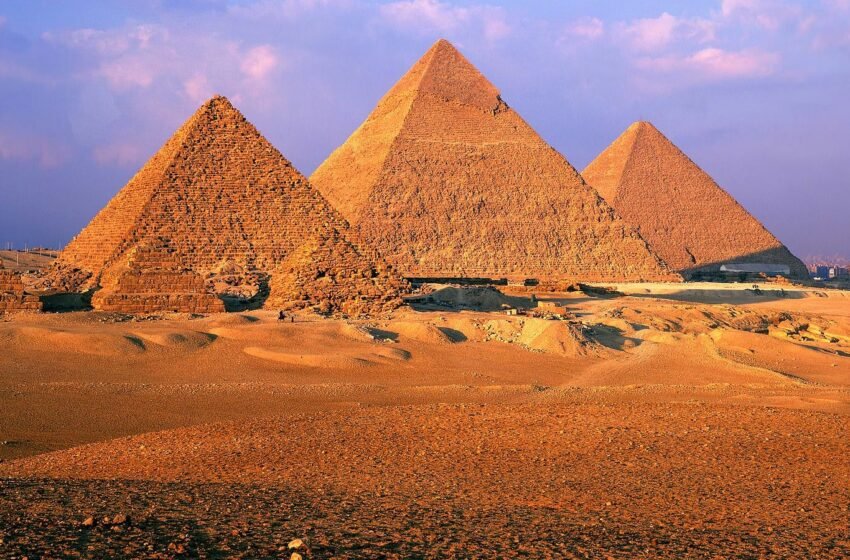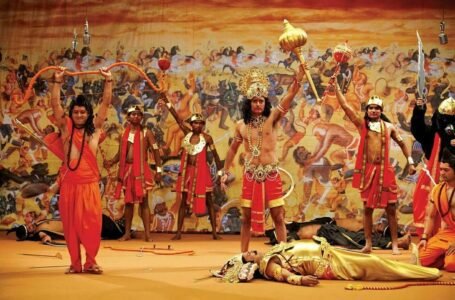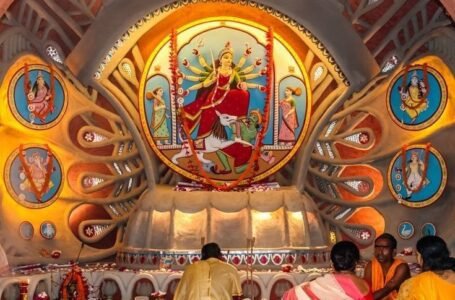The Art and Architecture of Ancient Egypt

Ancient Egyptian civilisation, one of the most iconic and enduring cultures in history, left an indelible mark on the world through its remarkable art and architecture. The legacy of Egypt is encapsulated in its monumental structures, intricate art, and profound religious and cultural symbolism that defined their way of life for over 3,000 years. This article merges detailed insights into both the architecture and art of ancient Egypt, exploring their development, symbolism, and cultural significance.
Ancient Egyptian Architecture
The architecture of ancient Egypt remains one of the world’s most impressive and recognizable achievements. It includes some of the most famous structures, such as the Great Pyramids of Giza and the temples of Thebes, and is known for its precision, scale, and durability. Building projects were state-sponsored and served multiple purposes, including religious, commemorative, and reinforcing the pharaoh’s authority. Egyptian architects and builders used simple tools and sighting instruments to create large stone structures that continue to be admired for their accuracy and precision.
Types of Structures
- Domestic Architecture: While elite and ordinary Egyptians lived in homes constructed from perishable materials like mudbrick and wood, most of these dwellings have not survived. The palaces of the elite and the pharaohs, however, were more elaborate, with New Kingdom palaces like those in Malkata and Amarna showcasing richly decorated walls and floors, featuring scenes of deities, people, water pools, birds, and geometric designs.
- Temples: Temples were the most enduring monuments of ancient Egypt, built to last forever with stone. The earliest temples consisted of a single enclosed hall with roof slabs supported by columns, as seen at Giza. In the New Kingdom, architects introduced more complex features such as pylons, open courtyards, and hypostyle halls, which became standard until the Greco-Roman period.
- Tombs: The tomb architecture of ancient Egypt is among the most famous in the world. The mastaba, a flat-roofed rectangular structure, was the most popular tomb form during the Old Kingdom. The step pyramid of Djoser, which consists of stacked mastabas, represents one of the earliest examples of large-scale stone construction. While pyramids were built during the Old and Middle Kingdoms, most later rulers shifted to less conspicuous rock-cut tombs. However, the pyramid form continued to be used in private tomb chapels in the New Kingdom and in the royal pyramids of Nubia.
Iconic Architectural Structures
- The Mortuary Complex of Djoser: Marking the beginning of large-scale stone buildings, Djoser’s mortuary complex featured post and lintel supports in the papyrus and lotus motif, symbolizing Egypt’s wealth and power.
- The Temple of Isis at Philae: An example of Egyptian architecture and architectural sculpture, this well-preserved temple showcases the characteristic stone construction and artistic detailing that is synonymous with Egyptian religious structures.
- The Temple of Dendur: Completed by 10 BC and housed in the Metropolitan Museum of Art in New York, this structure represents the grandeur of Egyptian temple architecture, exhibiting precision and artistry in every detail.
Art of Ancient Egypt
Egyptian art was created with a highly functional and symbolic purpose. The art produced by ancient Egyptian artists adhered to strict rules and conventions that remained consistent for over 3,500 years. These rules were designed to convey religious, political, and cultural ideas clearly and precisely. Art was not simply for decoration; it was an integral part of the Egyptian belief in the afterlife, royal power, and cosmic order.
Key Principles of Egyptian Art
- Symbolism and Iconography: Egyptian art is known for its use of highly symbolic and stylised representations. Figures were depicted according to strict conventions, with the body shown in profile and the head and torso presented from the front. This method of depiction, known as composite view, was intended to show each part of the body in its most recognisable form, rather than attempting a naturalistic or realistic portrayal.
- Art as Political and Religious Record: Egyptian art often served to record important historical events, such as military victories or royal decrees, and depicted religious scenes. These artworks were not just aesthetic objects but were integral to reinforcing the pharaoh’s divine power and the state’s order.
- Paint and Materials: Egyptian artists used stone for creating statues and fine reliefs, and wood for cheaper, more easily carved substitutes. Paints were derived from natural minerals such as ochres (for red and yellow), copper ores (for blue and green), soot (for black), and limestone (for white). These pigments were mixed with gum- arabic to create a binder, which allowed the paints to be pressed into cakes and moistened for use.
Funerary Art and Sculptures
Much of the surviving art from ancient Egypt was created for funerary purposes, intended to ensure that the deceased had everything they needed in the afterlife. Tomb art was meant to represent the ideal afterlife, with scenes of daily life, rituals, and gods.
- Shabti Statues: These small figurines were placed in tombs to serve as substitutes for the deceased in the afterlife, performing manual labor on behalf of the person who had passed.
- Books of the Dead: These texts, often accompanied by illustrations, were placed in tombs to guide the deceased through the trials of the afterlife.
- Funerary Models: During the Middle Kingdom, models depicting everyday scenes became popular additions to tombs. These models showed laborers, boats, houses, and military formations, representing the activities the deceased would enjoy in the afterlife.
Artistic Evolution
While Egyptian art remained remarkably consistent over the millennia, political and cultural shifts sometimes led to changes in style:
- Hyksos Influence: After the Hyksos invasion, Minoan-style frescoes were found in Avaris, showing the impact of foreign cultures on Egyptian art.
- Amarna Period: The most dramatic change in Egyptian art came during the reign of Akhenaten (Amenhotep IV), who introduced Amarna art, characterized by more naturalistic depictions of the human form. Akhenaten’s radical religious ideas, which centered around the worship of the sun disk Aton, also led to a new style of art. This form, which emphasised elongated forms and soft, rounded shapes, was quickly abandoned after Akhenaten’s death in favour of the traditional, stylised forms.
Portrait of a Middle Kingdom Ruler: Sesostris III
One of the most important examples of Middle Kingdom portraiture is a fragment of a portrait of King Sesostris III (c. 1878–1839 B.C.), which exemplifies the shift in artistic style during this period. This sculpture represents a significant departure from the idealized depictions of earlier rulers like Khafre. While earlier pharaohs were portrayed with calm, aloof expressions, Sesostris III’s face is more realistic—with firm lips, furrowed brow, and “worry” lines that convey a sense of weariness. This portrayal reflects the Middle Kingdom’s political environment, where rulers were seen less as divine figures and more as leaders whose authority was grounded in personal strength and leadership. The fragment, carved from red quartzite, stands 16.5 cm tall and is housed at the Metropolitan Museum of Art in New York.
Portrait of Akhenaton: Revolutionary Artistic Changes
The reign of Akhenaton (Amenhotep IV), who ruled during the New Kingdom, marked a radical shift in Egyptian art. Akhenaton, known for his religious reforms, introduced a new artistic style that focused on more naturalistic depictions of the human figure. Unlike the stiff, formal portraits of previous rulers, Akhenaton’s statues portrayed him with elongated features such as a long neck, pointed chin, and heavy lips. These representations symbolised a departure from the traditional divine kingship, highlighting a more personal, human aspect of the ruler.
Akhenaton’s portraits also depicted him in more intimate, everyday settings—such as playing with his daughters or walking with his queen, Nefertiti. This emphasis on realism was not just confined to royal portraits but also influenced the broader artistic culture of the period, which aimed to humanise the divine. Akhenaton’s influence on art continued even after his death, despite the abandonment of his religious reforms.
Relief Sculpture: Methethy with His Daughter and Son
The relief panel titled “Methethy with His Daughter and Son” (c. 2565–2420 B.C.) serves as a prime example of Egyptian art’s strict conventions. This relief features a depiction of Methethy and his children, rendered in the characteristic profile view of their heads, arms, and legs, while the eyes and shoulders are shown frontally. These conventions were designed to create a complete, recognisable image, rather than a realistic one. While these stylistic rules might seem unnatural by modern standards, they ensured clarity in representing the human form. The polychromed limestone relief is housed at the Nelson-Atkins Museum of Art in Kansas City, Missouri.
Rules of Egyptian Art
Egyptian art was governed by strict conventions that influenced the depiction of the human figure. The purpose of these conventions was to show the body in the most recognisable and complete way possible. The eyes and shoulders were always shown frontally to emphasise their importance, while other parts of the body were rendered in profile. These artistic rules were followed consistently throughout Egyptian history, regardless of whether the resulting figures appeared unnatural by modern standards.
This focus on creating a complete image was integral to the Egyptians’ belief in the afterlife. Sculptures of the pharaoh were intended to serve as substitutes for the body after death, ensuring that the deceased could exist in the afterlife in a recognisable and complete form.
Cartouche: Early Egyptian Picture Writing
A cartouche was a symbolic form of picture writing used in ancient Egypt, designed to represent the name of an important person. These oval symbols were often carved and used in inscriptions to signify the names of pharaohs and other significant figures. The cartouche, as an early form of pictogram, reflects the importance of writing and symbolism in ancient Egyptian culture. It was closely tied to the identity of the individual, and its use reinforced the belief in the sacredness of a ruler’s name and the eternal nature of their power.
The cartouche, typically enclosed in an oval shape, was often found on monuments, tombs, and other forms of commemorative art. It symbolised protection and immortality, conveying the idea that the person named within would be safeguarded by the gods. The use of the cartouche also signified the divine nature of the ruler, further emphasising their connection to the gods and their role as intermediaries between the divine and the mortal world.
Conclusion: The Legacy of Egyptian Art and Architecture
Ancient Egyptian art and architecture stand as a testament to the civilisations enduring legacy. Their art, created with highly structured conventions, was deeply rooted in religious and cultural symbolism, serving not only as aesthetic expressions but also as tools for ensuring stability, continuity, and divine favour in life and afterlife. The monumental structures of Egypt, from the grand pyramids to the finely crafted tombs and temples, continue to inspire awe and admiration across the world.


